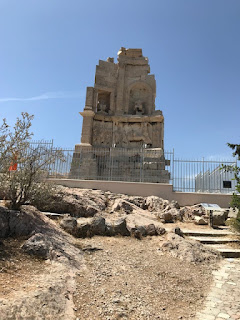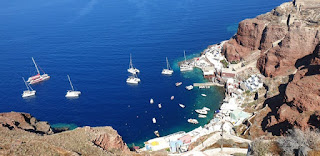I had my first experience of island hopping in Greece when I was in my early 20s (a very long time ago).
Phil had a Greek Godfather so he was able to offer a wealth of knowledge about the area including help with the ferries so off we went with our rucksacks backpacking. However, on this island-hopping holiday a sleek yacht was to be our base, island hopping through the Aegean sea on the Panorama.
An anxious start to our holiday though as British Airways cancelled our flight. Not deterred we decided to go a day earlier arriving in Athens at one in the morning. Second problem our mini bus had not turned up but a taxi was quickly arranged for us and Clive and Rosie! Four of us in a yellow taxi with all our bags!!!!!! He was a lovely taxi driver and we were quickly delivered to our hotel.
Our hotel, the Philippos was in a perfect location minutes from the Acropolis and within walking distance to all the major tourist attractions but on a side road with limited traffic and with a view of the Acropolis from our bedroom window. A hidden gem.
Tuesday, 24th May, 2022
After breakfast our first stop was Hadrian's Arch. This is located just outside the Temple of Zeus. The Arch was commissioned by the Roman Emperor Hadrian, and remarkably it has survived through to this day. If you get the camera angle right, you can see the Acropolis on the hill behind it. By visiting here first we were able to buy the combined ticket for archaeological spaces in Athens with no queue (by the entrance to the Temple of Zeus). It's far better to do this than join a massive line for tickets at the Acropolis! Valid for 5 days for Acropolis and Slopes. Ancient Agora. Hadrian's Library. Kerameikos. Aristotle's School (Lykeion). Olympieion. Roman Agora and costs 30 Euros. One visit per site.
We then headed through the lush National Gardens heading for Syntagma Square and Changing of the Guards. The gardens are a rare area of greenery in the city centre, originally known as the Royal Gardens, and is home to over 500 species of trees and bushes. We also passed a building known as the Zappion, a grand looking neo-classical building. But the building is more than just a backdrop. During Ottoman rule, much of the Greek elite, intelligentsia, and aristocracy fled the country. They returned after independence and built grand mansions such as this. Finished in 1888, it was designed by the Danish architect Theophilus Hansen, who was known (along with his brother Christian) for his Neoclassical designs. The financing was provided by the Zappas brothers, Evangelos and Konstantinos, two of the prime movers in the campaign to revive the Olympic Games. This mansion housed the International Olympic Committee during the first modern Olympics in 1896 and served as a media centre during the 2004 Olympics. Today the Zappeion is a conference and exhibition centre.
Next stop. Syntagma Square, crowned by the imposing Parliament building on its upper side and surrounded by other large structures, such as the exclusive Hotel Grande Bretagne. The Tomb of the Unknown Soldier is positioned just in front of the Parliament Building and is guarded day and night, by two fancifully dressed Evzone guards.. The tomb itself is simple - a marble slab marked only with a cross. Carved into the wall above is an image of a fallen warrior from ancient times, with helmet and shield. On either side are the names of great battles in Greek history since 1821 On the hour, every hour, the guards change and it is a one-of-a-kind spectacle not to be missed. The guards were wearing the brown skirt uniform which is their winter uniform although it was 29 degrees!!! Their shoes have spikes on the soles and you can hear the shoes tap and scrape on the marble. We found a good position to watch and it was really fun to watch them move with a slow-motion, high-stepping gait to their new positions. The loud stamping sound the guards make with their boots had special meaning, and it was to remind a king of his homeland and that ancestors can hear they are alive and free. Why do they have pompoms on their shoes? They were worn by farmers and men who worked outdoors in Greece because they were durable, high quality, and long-lasting and they would protect the toes from the snow and cold and helped to make them waterproof. The pom pom on the tip of the tsarouchi is also said to symbolise the tree of liberty. When worn by soldiers, inside the pompom, there is traditionally a small blade that symbolises the kick that the brave man who wears it will give to every enemy who dares to threaten or hurt the tree of liberty. A pair of tsarouchia an Evzone wears weighs an incredible two and half kilograms. The red colour on the shoe symbolizes the blood of ancestors and the black coloured pompon 400 years of life under Ottoman rule.
Then over the road for an obligatory photo by the fountain.
The walk from the Tomb of the Unknown Soldier to Panathenaic Stadium takes five or ten minutes, depending on how long you spend in the Gardens. We crossed a busy road and then saw the stadium. If you are into sports you'll want to go inside the Panathenaic Stadium, which hosted the first modern Olympic Games in 1896. The audio tour was included in the price and it really helped to get a feel for it. Epic views also from the top tiers.
After all that exercise back to our hotel for a siesta followed by roof top bar cocktails, with an impressive view of the Acropolis, at the sister hotel Herodion. It was so lovely to watch the light change as the sun set. The perfect end to a day in Athens.
Wednesday, 25th May, 2022
Up early to visit The Acropolis before the crowds. The highlight of the trip to Athens. What can I say? It is just awesome! The privilege to stand at the very place of living history of many thousand years. The masterpiece of architecture, sculpture and mechanics.
We entered by the south entrance, at the base of the Acropolis and next to the Acropolis Museum. It was a steep-but-shady tree-lined path and our first stop was the Theater of Dionysus and the Odeion of Herodes Attikus. The Odeion is actually some people's favourite part of the Acropolis complex. Once at the top of the Acropolis are the significant buildings such as the Parthenon, Erecthion, Temple of Athena Nike, and Propylaia. Note that the Caryatids you see here are replicas, with the real ones on display in the Acropolis Museum.
We then headed to Mars Hill (Areopagus). The knobby hill crawling with tourists near the Acropolis' main entrance, at the western end. The stone stairs (and the top of the rock) have been polished to a slippery shine by history. This is where St. Paul preached about the Unknown God to the Athenians. A plaque embedded in the rock near the stairs contains the Greek text of Paul's speech.We continued walking to the Ancient Agora. While the Acropolis was the ceremonial showpiece, the Agora was the real heart of ancient Athens. Agora means "gathering place". Little survives from the classical Agora. Other than one very well-preserved temple and a rebuilt Stoa, it's a field of humble ruins. But that makes it a quiet, uncrowded spot to wander and get a feel for the ancients. Nestled in the shadow of the Acroplis, ideal after our visit there.
Definitely time for lunch!
Located across the street from the Acropolis is the Acropolis Museum. It is an amazing building. The modern style museum is well thought out and placed. Designed to hold antiquities from the Parthenon and Acropolis especially the marbles at the top, although many are in the British Museum, yet to be returned. The museum is a sort of 21st-century Trojan horse, intended to lure the "Elgin Marbles" back to Athens. For years, the Brits have claimed that Greece can't give those ancient treasures a suitable home. But now Athens can proudly say, "oh really?". The placement allows for a full view facing the Parthenon, lots of natural light, and preservation of these priceless objects. There are also ancient excavations beneath the museum. Known as one of the top ten museums in the world, with good reason.
Thursday, 26th May, 2022
Before it became too hot we set off for Temple of Olympian Zeus. Begun in the sixth century BC, it wasn't finished until the time of the Roman emperor Hadrian 700 years later. It was the biggest temple in all of Greece with 104 Corinthian pillars housing a 40-foot seated statue of Zeus. The size and number of columns in the temple were massive. Although a relatively small portion of the temple still exists, it's easy to visualise just how magnificent the temple was in its day.
Included in our combined ticket was Kerameikos Cemetery. This ancient monument appears to be little known as it is outside the main area in Athens and a 30 minute walk from our hotel. This is another incredibly important part of ancient Athens with the remains of the city walls visible.
This ancient cemetery contains some very impressive finds. A visit to the well organised museum gives the site some context and is worth visiting in itself to view the marvellous kouros figure found there in recent years. The pictures of it in its location and being recovered are fascinating. The site itself is interesting and there are information boards around to explain the areas. If you are lucky you can also spot a native tortoise or two wandering around.
After the cemetery it was time for a stroll on one of the most picturesque areas of Athens. Filopappou Hill. Climbing to the top on a decent path allows fantastic views of the Acropolis, other hills, the city and even the sea with a couple of islands. At the top there is a marble funerary monument to a popular Roman senator, Philopappos, who died in the early second century. This hill is where the Venetians launched the infamous mortar attack of 1687 that destroyed the Parthenon. We enjoy a few final moments with the Acropolis before we leave Athens.
We returned in the evening to the rooftop bar at the Herodion hotel for a fabulous meal with a view.
Friday, 27th May, 2022
A quiet morning before pick up for transfer to our ship. We enjoyed a delicious lunch at To Kati Allo Restaurant. Immediately under the far side of the Acropolis Museum is this hole-in-the-wall with cheap, fresh and tasty local options. Followed by a delicious local ice cream.
This evening we depart from Athens and head towards the Greek Islands on our voyage to uncover the stunning islands around the Cyclades. Protocols are strict, however, when it comes to health and safety, with a lateral flow test before boarding. With bated breaths we await the results. Yes we may go to our cabins. All the guests pass and at 6 p.m. we departed Athens Marina Zea and set sail for Kea.
All aboard!
Short stop at Kea.





























































































No comments:
Post a Comment